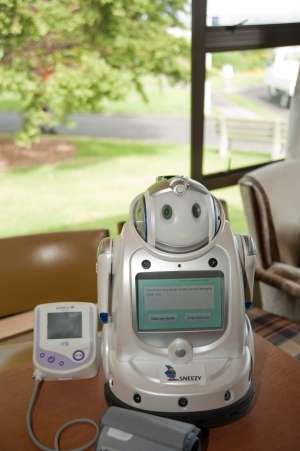Robots help with rural elderly healthcare

Healthcare robots in the homes of independent elderly rural residents may help lessen social isolation and help with medical care, according to new research from the University of Auckland.
In the first study of this type, it was found that the healthcare robots functioned as good companions. Some participants enjoyed hearing the robot talk and interacting with it. Others liked the robot reminding them to take their medicine on time.
Five participants trialled the robots in their homes for at least three months.
"The results suggest the healthcare robots were feasible for use with a rural population and may have benefits for some patients in reducing the need for medical care, increasing quality of life, reminding patients to take medicine on time, and providing companionship," says study senior author, Dr Elizabeth Broadbent from Psychological Medicine at the University of Auckland.
"Patients said that having the robot felt like they had a companion in the house and they didn't feel so alone," she says. "An unexpected finding was the robot's blinking lights - the lights enhanced the robot's social presence which was reassuring to patients and helped them see when the surroundings were dark late at night or in the morning."
"Patients found comfort in seeing the robot light up, as they felt it was the robot's way of interacting with them", says Dr Broadbent. "They all reported that they would miss the robot when it went with one patient describing the robot as being part of the family."
The study also highlighted several ways the health robots could be changed to enhance the experience of people having them in their homes.
These include improvements in the robots' design and functions, such as installing more familiar games for older people, a larger function screen and a screen with less sensitivity to accidental triggering, and a simpler Skype interface.
"These suggestions arise from real-world experiences and not a lab-based setup," says co-author Professor Bruce MacDonald from the University's School of Engineering. "Trialling the healthcare robots with patients in their homes is a strength of the study."
"Despite encountering some technical issues, patients were mostly positive and accepting of the robot", he says.
"Caring for older people with chronic conditions living independently in rural communities has many challenges, from geographic isolation and lack of transport to a shortage of medical care professionals," says Gore Health CEO Karl Metzler who helped facilitate the study.
"Especially for those living alone, managing chronic illnesses can be difficult and it can be hard for some to follow medication schedules as they get older," he says. "Rural older adults also experience loneliness and concern about a loss of independence and institutional care."
"Having older people living independently in their own homes for as long as possible is the most favourable option and socially assistive robots may help them care for themselves for longer," he says.
Although the study showed a decrease in the rate of patients' primary care visits and calls to the doctor, these could not be attributed for certain to the presence of the robot. The small sample size was limited by the number of healthcare robots available.
Provided by University of Auckland




















